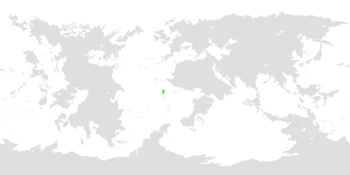Hazala: Difference between revisions
No edit summary |
No edit summary |
||
| Line 61: | Line 61: | ||
|area_label2 = <!-- label below area_label (optional) --> | |area_label2 = <!-- label below area_label (optional) --> | ||
|area_dabodyalign = <!-- text after area_label2 (optional) --> | |area_dabodyalign = <!-- text after area_label2 (optional) --> | ||
|population_estimate = | |population_estimate = 2,230,000 <br> | ||
|population_estimate_rank = | |population_estimate_rank = | ||
|population_estimate_year = 2020 | |population_estimate_year = 2020 | ||
Revision as of 17:37, 2 April 2020
Republic of Hazala Hazala
(Hazalan) | |
|---|---|
|
Flag | |
| Motto: '"!" The One Blessed Isles! | |
| Anthem: Majagrundi (traditional battle cry). | |
 | |
 | |
| Capital and largest city | Bourandi (ᒥᐊᓅᕙ) |
| Ethnic groups (2014) |
|
| Religion | Reformed Communion of Hazala, traditional Hazalan |
| Demonym(s) | Hazalan |
| Government | Federal Republic |
• Vhinti (President) | Nonhaj Huut |
| Establishment | |
• First settlers arrive in Kilalurak | 900 AC |
• Sáillinnciadi sailors first arrived on Hazalan shores, conquest of Hazala | 1535-1570 AC |
• Hazalan independence recognized | 1947 AC |
• Water (%) | XXX |
| Population | |
• 2020 estimate | 2,230,000 |
• 2019 census | 2,234,000 |
| GDP (PPP) | 2016 estimate |
• Total | $57 billion |
• Per capita | XXX |
| Gini (2015) | 22.1 low |
| HDI (2018) | 0.5512 medium |
| Currency | Kilalurian Sivinik (ᙟ) (KLV) |
| Time zone | UTC-11:00, -10:00 |
| Date format | dd-mm-yyyy |
| Driving side | right |
| Calling code | +474 |
| ISO 3166 code | KL |
| Internet TLD | .kl, .kila, .klrak, .krk |
Hazala, officially the Republic of Hazala (Dánila Ripóna gi Hazala), is an island nation in the Mid-Allonian Ocean. The islands first formed about 70 MYA, caused by subduction of the [X] plate. Many unique endemic flora and fauna have inhabited the islands, including ratites, rails, stem-sirenians, terrestrial crocodilians, and many different groups of birds. About 1,100 years ago, human settlers from western Dihara arrived on the shores of Ulungo, bringing with them dogs, chickens, and yams. Many native species went extinct, including all the massive gharun (giant. Flightless birds), the cattle-sized bout, and all of the terrestrial crocodiles except for the arboreal janjir (also known as the Hazalan tree crocodile).
For about 650 years, Hazala remained isolated from the outside world. Many tribes split off, and farming communities appeared in the highlands of Ulungo. Narcotics played an important part in pre-contact culture, being consumed for religious, casual, ritualistic, and celebratory purposes - some particularly bold and confident warriors would get intoxicated before battle. Speaking of, wars were more ritualistic than the Auroran concept of it, with low casualties and more over minor disputes than major ideological or religious reasons. Chickens served as the main livestock, with dog consumption being considered taboo (except in extreme circumstances).
In 1535, Sáillinnciadi sailors first arrived on Hazalan shores. What began as trade soon became conquest, and by 1570 all of the islands were under colonial rule. Arboran rule caused another wave of extinction, largely due to the introduction of rats, cats, and pigs, as well as habitat destruction. One of the most important events of the colonial period on Hazalan culture was the introduction of Vayonism, specifically Reformed Vayonism, which was hybridised with local beliefs to form a new, uniquely Hazalan form of Vayonism.
In 1942, growing tensions with the homeland lead to a full on revolution. With foreign backing, Sáillinnciad recognized Hazala as an independent nation. After several decades of instability and dictatorships, the islands entered an era of relative prosperity in the late 1980’s. Today, the main industries are tourism (mainly the pristine beaches, beautiful coral reefs, and comparatively well preserved forests) and the export of cocoa and sugar.

